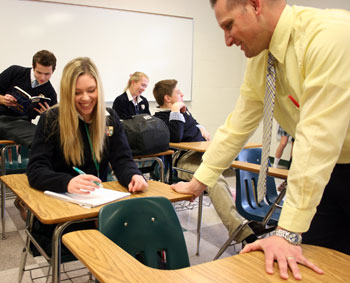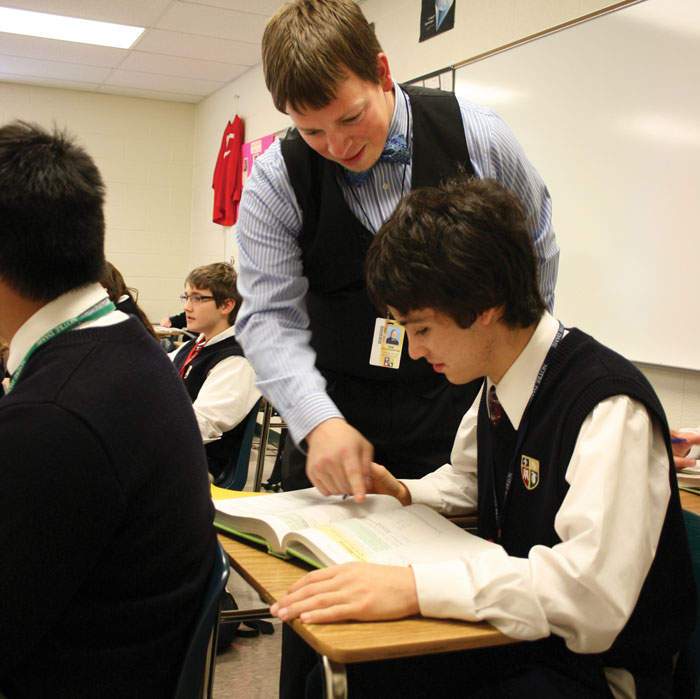Watching TV or a video on a computer screen during what should be homework time usually is verboten in most households with school-age kids. But today, your son or daughter may actually be doing their homework. That’s because many teachers and many high schools are adopting the “flipped-learning” model of classroom instruction.
According to Flipped Learning Network, an education advocacy group headquartered in Arlington, Virginia, in a flipped-learning setting, teachers make lessons available to students to be accessed—usually by recorded video—whenever and wherever it is convenient for the student: at home, in class, during study hall, “on the bus to a game, or even from a hospital bed.” Teachers usually prerecord a video of their own lecture or provide access to a trusted third-party lecture. Students then can watch the videos or podcasts as many times as they need to, which according to FLN enables them to be more productive learners in the classroom. Because a lecture or direct instruction is delivered outside the classroom, teachers can use in-class time to actively engage students in the learning process and provide them with more individualized support.
Many schools across the country are embracing this concept in part or in total. In the Detroit area, Clintondale High School in Clinton Township has totally jumped on board with flipped learning. According to principal Greg Green in a story published in December by PBS NewsHour, failure rates for students at Clintondale have declined dramatically since they adopted the innovative process in 2010, and test scores also have improved.
“We feel we’ve perhaps figured out the structure of the way schools should be set up,” Green said. “And we’re trying to make it an ideal situation for both the learners and the teachers.”
Those in favor of flipping say it gives teachers much more time in class to work individually with students and much less time delivering potentially boring lectures. And it allows the students the opportunity to watch and re-watch a lecture as many times as necessary to “get it.”
A number of teachers at Notre Dame Prep also are actively engaged in flipped learning. Daniel Staniszewski, a math teacher in Notre Dame’s upper school, says he has seen a strong positive result in his students. He’s been “flipping” in his geometry class since January 2013.
“Many of my students are getting higher grades and they’ve reported increased enjoyment of math,” he says. “I’m using it primarily for freshmen and sophomores in geometry class, but I also use it for sub plans in other classes, allowing a lecture and homework component when I am unable to be at school.”
Brian Perry, a social studies teacher at NDP, says his students have had a positive response to the flipped classroom concept, which gives him much more time in the classroom for individual student help.
ND Prep science teacher Sue Wylie also has been using the flipped classroom method since last year. She says the results have been mixed. “But I think those students who actually sit down and watch the videos in a quiet area, and back up and re-watch what they do not understand, are seeing better results.”
Flipped mastery learning
The “mastery learning” method of teaching has been around for a long time—since the early 20th century, actually. Its basic premise is that each student must master a subject or unit at his or her own pace before moving to the next one—a much different model than having every student advance at the same time regardless of subject mastery.
Mastery learning has been shown to be quite successful when applied in the classroom. But it obviously creates huge problems due to a wide degree of differences in how 15 or 20 students in a classroom handle any given subject.
Now, with the popularity of flipped learning continuing to grow, it’s providing the opportunity for teachers to better work individually with students in the classroom, making sure those that need extra help get it.
Melissa Archer, who’s been teaching English and other subjects at Notre Dame Prep for more than 15 years, also has been flipping some of her classes. She says the process of shifting the paradigm of what homework is will take time. “But on the positive side, those who have done the flip work at home are ready to use it in practical means. As an example, instead of using class time to instruct and review countless disconnected activities, I have my students identify grammar in context and apply the concept in their own writing. This is much more valuable.”
In upper-school teacher Brian Perry’s AP Psychology class, he also says the kids have responded positively. “The students like the ability to go back and watch video lectures and pause and rewind so they can hit the notes they may have missed. They also like the fact they can retrieve a document that may have been lost.”
Into the future
Going forward for Notre Dame, Joanne Widmaier, Notre Dame’s registrar and academic technology coordinator, says the school’s academic administrators are not mandating a flipped approach to classroom teaching for everybody. “But if students can view lectures at home on any device, and then spend the next day actively working on mastering the concepts as opposed to passively sitting through the lecture, it’s probably a good thing for both teacher and student,” she said. “The ability to pause, rewind and re-watch videos allows a student to spend more time on concepts they find challenging—both at home without the teacher or in class with. Also, it helps students who miss class due to illness, sports or school trips.
“We think it’s a concept that won’t work for everybody, but we are flexible enough here to allow it to work for those who may need it.”
Follow Notre Dame at @NDPMA.
About Notre Dame Preparatory School and Marist Academy
Notre Dame Preparatory School and Marist Academy is a private, Catholic, independent, coeducational day school located in Oakland County. The school's upper division enrolls students in grades nine through twelve and has been named one of the nation's best 50 Catholic high schools (Acton Institute) four times since 2005. Notre Dame's middle and lower divisions enroll students in jr. kindergarten through grade eight. All three divisions are International Baccalaureate "World Schools." NDPMA is conducted by the Marist Fathers and Brothers and is accredited by the Independent Schools Association of the Central States and the North Central Association Commission on Accreditation and School Improvement. For more on Notre Dame Preparatory School and Marist Academy, visit the school's home page at www.ndpma.org.

